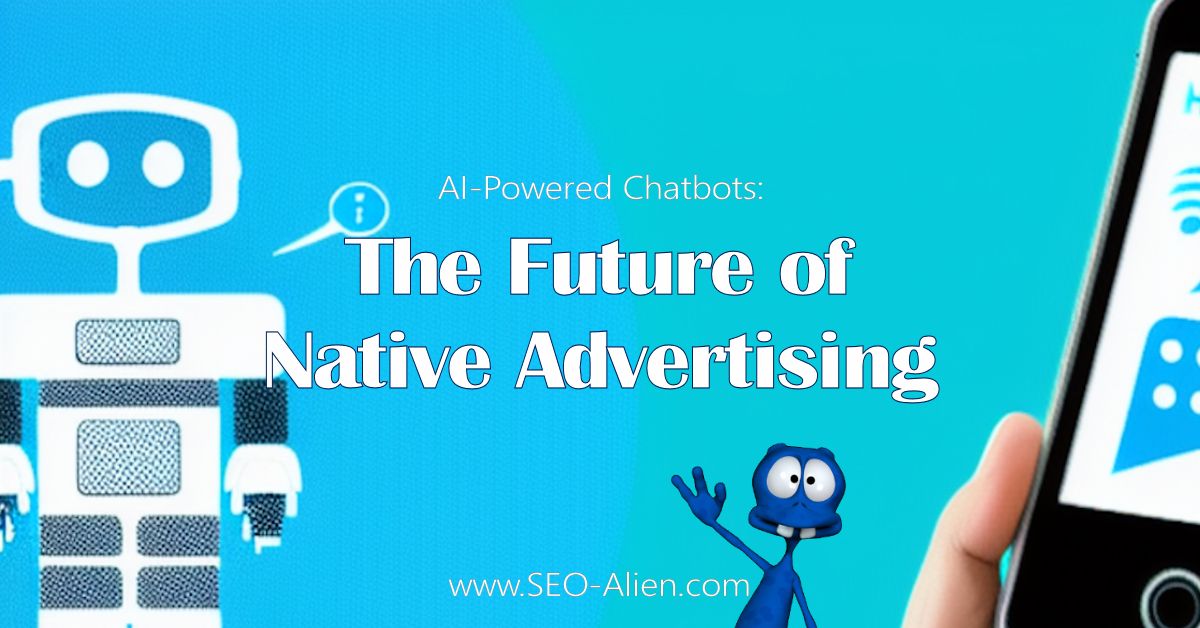As technology continues to advance, businesses constantly seek innovative ways to engage with consumers and boost sales.
One such technology that has gained significant traction in recent years is AI-powered chatbots, which hold the potential to transform how companies approach native advertising.

Made with DesignCap
In this article, we will discuss what AI-powered chatbots are, their role in native advertising, the benefits they offer, and the challenges and considerations to keep in mind. We will also examine the future of AI-powered chatbots and their potential impact on native advertising.
What are AI-Powered Chatbots?
Chatbots, at their core, are computer programs designed to mimic conversation with human users. They utilize natural language processing (NLP) and machine learning algorithms to interpret user input and generate suitable responses.
AI-powered chatbots elevate this technology by employing advanced machine learning algorithms to learn from user interactions and improve over time, rather than relying solely on pre-programmed responses. This enables them to deliver more accurate, personalized responses to users and manage increasingly complex interactions.
Designed to be more human-like in their interactions, AI-powered chatbots can lead to a more enjoyable user experience. They have a wide range of applications, including customer support, marketing, and sales.
The Role of Chatbots in Native Advertising
Native advertising refers to a form of advertising that seamlessly blends in with surrounding content, as opposed to appearing as traditional banners or display ads. Its purpose is to deliver value to the user, such as educational content or entertainment, while still promoting a product or service.
Chatbots can play a crucial role in native advertising by offering a more personalized and engaging experience for users. Here are some real-life examples of how chatbots can be utilized in native advertising:
#1 Product Recommendations
Chatbots can analyze a user's browsing history and preferences to provide personalized product recommendations, increasing the chances of a sale.
For instance, Sephora, a popular cosmetics retailer, uses a chatbot on their Facebook Messenger platform to offer personalized product recommendations and makeup tutorials to customers. The chatbot leverages data about a customer's skin tone and makeup preferences to provide tailored recommendations, boosting the likelihood of a purchase.
#2 Customer Support
Chatbots can provide customer support within a native advertising experience, such as assisting users in troubleshooting a product issue or answering questions about a service.
For example, Domino's Pizza, a global pizza delivery chain, uses a chatbot on their Facebook Messenger platform to process orders and address customer inquiries. The chatbot can handle a wide array of interactions, reducing the need for human customer support and enhancing the overall customer experience.
#3 Interactive Content
Chatbots can create interactive content, such as quizzes or games, promoting a product or service in an engaging and enjoyable manner.
For example, cosmetics brand CoverGirl developed a chatbot on Kik, a messaging app, to promote their "Katy Kat" lipstick line. The chatbot allowed users to take a quiz to identify their lipstick personality and provided personalized product recommendations based on the quiz results.
The Advantages of AI-Powered Chatbots in Native Advertising
There are several benefits to incorporating AI-powered chatbots into native advertising:
- Increased engagement: Chatbots offer a more interactive and personalized experience for users, leading to higher engagement and a greater likelihood of conversion.
- Personalized content: AI-powered chatbots can use data about a user's browsing history and preferences to provide tailored recommendations and content, making the native advertising experience more relevant and valuable to the user.
- Cost-effective: Chatbots can handle numerous interactions simultaneously, reducing the need for human customer support or sales staff. This can result in substantial cost savings for businesses.
- Increased customer satisfaction: Increased customer satisfaction: AI-powered chatbots can deliver immediate and personalized support to users, improving overall customer satisfaction and loyalty.
How AI Technology is Improving Chatbot Capabilities
Advancements in AI technology continually enhance chatbot capabilities, making them more efficient and effective. Here are a few ways in which AI technology is improving chatbot capabilities:
Natural Language Processing (NLP)
One of the most significant challenges for chatbots is understanding and interpreting natural language input from users. AI-powered chatbots utilize NLP algorithms to analyze and comprehend user input, enabling them to provide more accurate and relevant responses.
NLP algorithms combine machine learning, deep learning, and statistical techniques to analyze language and extract meaning. This allows chatbots to identify keywords, understand user intent, and generate appropriate responses.
Sentiment Analysis
Sentiment analysis involves analyzing text to determine the emotional tone or attitude of the writer. AI-powered chatbots can employ sentiment analysis algorithms to identify user input sentiment, allowing them to respond suitably to users who may be frustrated or upset.
Sentiment analysis algorithms use machine learning techniques to identify patterns in language associated with particular emotions. This enables chatbots to adjust their responses to match the emotional tone of the user, enhancing the overall user experience.
Machine Learning
Machine learning, a subset of AI, allows chatbots to learn from user interactions and improve over time. Chatbots can identify patterns and trends that help them provide more accurate and relevant responses.
Machine learning algorithms use statistical techniques to analyze data and identify patterns. By applying these algorithms to user interactions, chatbots can learn to recognize and respond to common user queries more effectively, improving the overall user experience.
Personalization
AI-powered chatbots can use data about a user's browsing history and preferences to provide personalized recommendations and content, making the native advertising experience more relevant and valuable to the user. This is achieved through machine learning algorithms that analyze user data and generate recommendations based on past behavior.
Future Advancements in AI Technology for Chatbots
The potential for AI-powered chatbots is vast, with several future advancements on the horizon that could further enhance their capabilities. Here are a few examples:
Emotional Intelligence
AI-powered chatbots may soon be capable of detecting emotions in user input and responding accordingly. This could lead to even more personalized and human-like interactions. For example, a chatbot designed for mental health support could detect signs of distress in a user's text input and offer appropriate resources or guidance.
Multi-lingual Support
As AI technology continues to improve, chatbots may become better at handling multiple languages and dialects, making them more accessible to users worldwide. For example, a travel company could use a chatbot to provide information and assistance to tourists in their native language.
Visual Recognition
AI-powered chatbots may soon be able to recognize visual input, such as images or videos, and respond accordingly. This could open up new possibilities for interactive content within native advertising. For example, a fashion brand could use a chatbot to provide outfit suggestions based on user-submitted photos.
Contextual Understanding
AI-powered chatbots may soon be able to better understand the context of user input and provide more accurate and relevant responses. This could lead to more efficient and effective interactions with users. For example, a chatbot designed for customer support could better understand a user's issue and provide a quicker and more appropriate resolution.
Voice Recognition
AI-powered chatbots may soon be able to understand and respond to voice input, allowing for more natural and intuitive interactions with users. This could be especially useful for chatbots designed for use in the car or other situations where typing is not feasible. For example, a voice-enabled chatbot could provide hands-free navigation assistance while driving, allowing users to request directions, traffic updates, or nearby points of interest without taking their hands off the wheel or eyes off the road, ensuring a safer and more convenient experience for the driver.
Challenges and Considerations for Using AI-Powered Chatbots in Native Advertising
While the potential benefits of AI-powered chatbots are clear, there are also some challenges and ethical considerations to keep in mind. Here are a few examples:
- Ethical considerations: Chatbots may be able to manipulate users through persuasive language or subtle suggestions. It's essential for businesses to use chatbots ethically and avoid any practices that could be seen as manipulative.
- Technical challenges: Chatbots can struggle with complex interactions or unusual user input. Businesses need to ensure that their chatbots can handle a wide range of interactions and respond appropriately.
- User trust: Some users may be hesitant to interact with chatbots, either because they don't trust the technology or because they prefer to speak with a human representative. Businesses need to work to build trust with users and make it clear when interactions are with a chatbot versus a human.
- Security and privacy: AI-powered chatbots may collect and store sensitive user data, such as personal information or browsing history. It's essential for businesses to take steps to protect user privacy and ensure that data is secure.
Conclusion
As AI technology continues to evolve, we can expect even more advancements in chatbot capabilities, such as emotional intelligence and visual recognition. However, it's important for businesses to approach chatbots ethically and ensure that they can handle a wide range of interactions.
The future of native advertising is bright, and AI-powered chatbots will undoubtedly play a key role in shaping that future. Embracing this innovative technology will help businesses stay ahead of the curve and provide a better experience for their customers while also benefiting from the cost savings and increased efficiency that chatbots provide. As we move forward, it is crucial for businesses to remain aware of both the potential benefits and challenges of incorporating AI-powered chatbots into their native advertising strategies.
About the Author:
The SEO-Alien is a project started in 2009 regarding all things online marketing. The site started out more of a diary of predictions, suggestions and references to things I frequently used for online marketing... before social media marketing was even an option.
I hope you find the information and tools presented here useful and something worth sharing with others.
If there is anything else about online marketing or any online advertising strategy you think would be helpful, please let me know.



